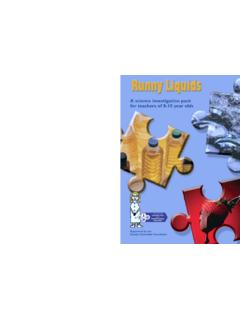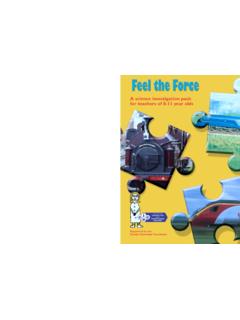Transcription of A science investigation pack for teachers of 7-11 year olds
1 Supported by the Gatsby Charitable FoundationA science investigation pack for teachers of 7-11 year oldsFor more information on the programmes and publications available from the CIEC, visit our website contact:Chemical Industry Education CentreUniversity of YorkYorkYO10 5DD UKTelephone: 01904 432523e-mail: Turf Troubles A science investigation pack for teachers of 7-11 year olds This package was developed by the Chemical Industry Education Centre at the Department of Chemistry University of York Heslington York YO10 5DD Telephone: 01904 432523 Facsimile: 01904 434460 E-mail: Website: Chemical Industry Education Centre First Published 2003 ISBN 1 85342 585 0 The contents of this book have limited copyright clearance.
2 They may be photocopied or duplicated for use in connection with teaching within the establishment for which they were purchased. They may not be duplicated for lending, hire or sale. Acknowledgements Many people were involved in developing the activities in this resource and subsequent trialling, and we would like to offer my thanks to them, and in particular: Anne-Marie Allen, St. Joseph's Primary School, Boston Spa Jonathan Barton, Advisory teacher , Children Challenging Industry, Chemical Industry Education Centre Edith Fielding, St-Michael-in-the-Hamlet Junior School, Liverpool Valmai Firth, Chemical Industry Education Centre Michelle Goundry, Heighington Primary School, Newton Aycliffe Katy Harris, Carlinghow Princess Royal Primary School, Batley Heidi Henrickson, Chemical Industry Education Centre Julie Jones, Advisory teacher , Children Challenging Industry, Chemical Industry Education Centre Fiona Law.
3 St. Mary's Primary School, Malton Mandy Martin-Smith, Cheyne Middle School, Sheerness Eve Morris, Barkston Ash Primary School, Barkston Gayle Pook, Advisory teacher , Children Challenging Industry, Chemical Industry Education Centre Sue Pooley, Heworth , York Cliff Porter, Educational Consultant Bryan Jackson Joy Parvin Project Officer Editor Photograph acknowledgements We thank the following companies, organisations and individuals for giving us permission to use photographs.
4 The numbers refer to the pages on which they can be found. Image of Fiona Crossley, Research Officer, using a Clegg impact soil tester to determine the hardness of turf surfaces. Courtesy ; STRI (Sports Turf Research Institute), Bingley, West Yorkshire, BD16 1AU, cover Children from Kerr Mackie Primary School, Leeds, Graham Mathers (photographer), cover Mowers at one of Rolawn's field sites, Rolawn Turf Growers Ltd, Elvington, York, YO41 4XR, cover Sweeping lawn, Valmai Firth, 15, 35 Turf field, Rolawn Turf Growers Ltd, Elvington, York, YO41, 4XR, 35 Grass identification illustrations reproduced from The Lawn Expert by Dr D G Hessayon.
5 36 Contents Introduction 1 Curriculum links 3 Resource requirements 4 Activities 5 Activity sheets 15 Appendices 35 1 Introduction Age range The activities in this book provide opportunities for children in Years 3-6 to investigate various conditions of growth of plants, to discover which will produce the best crop.
6 Context The context is that of a sports company who wish to provide a turf surface at a sports ground that is suitable for a range of sports and activities1. They need information on suitable types of grass and the best conditions for growth. They also need to apply for a water abstraction licence from the Environment Agency, and need to know how much water will be needed by the grass, as well as the effect of the ground type on water absorption. The context is closely related to actual problems facing companies. The Sports Turf Research Institute (STRI) in West Yorkshire was set up in 1929 to undertake research and provide advice for golf clubs, but it has subsequently become the market leader in turf grass research and agronomy.
7 It now advises golf and sports clubs, local authorities, stadium venues, and amenity grasslands throughout the world. Thus, any company wishing to build a new golf course or sports ground will almost certainly refer to the STRI for information on types of grass, and the conditions required to grow it successfully. Similarly, should anyone not on the mains water supply want to take water from the environment, a water abstraction licence must be obtained from the Environment Agency if a stream, river, pond or well is to be the source of water.
8 The licence holder is charged by the 1000 cubic metres of water, and the licence can be quite expensive, so the calculations for the amount of water needed have to reasonably accurate! In the case of farmers wishing to irrigate crops, the calculations involve the size of the field, the soil type, the soil water deficit (how good the soil is at retaining water) and the crop type. In these activities the children are able to investigate two of these, the soil type and the soil water deficit. Appendices 1-3 give further background information on grasses.
9 Activities The activities take approximately 3-4 hours, and can be completed over a 3 week period. Appendices 4-5 provide lesson plans, as well as a sample assessment grid for one investigation . Activity sheets are included to help children record their ideas, measurements and findings. At Key Stage 2 children are expected to '..talk about their work and its significance, and communicate ideas using a wide range of scientific language, conventional diagrams, charts and graphs'. It is hoped that the formats provided will increase the children's enjoyment of science by appreciating the variety of ways in 1 Although the context is that of turf growing for sports grounds, the teacher may prefer to grow a different plant, or 'crop' to link with a specific school visit or topic.
10 See the teaching notes for Activity 2 for further suggestions. 2 which they can record their work. The formats are also intended to support differentiated teaching in the classroom. Title Description Page Timing 1a Top turf (Years 3-4) A newspaper article stimulates an investigation into the factors required for healthy plant growth (light, temperature, water and air). The investigative focus is on developing skills of prediction, measuring, recording and considering the evidence.



